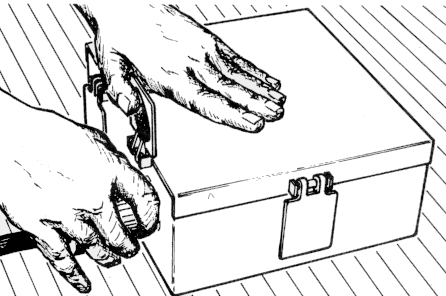Preventing Electrocutions of Workers in Fast Food Restaurants
December 1984
DHHS (NIOSH) Publication Number 85-104
Background
On June 30, 1984, an 18-year-old male worker in a fast food restaurant died by electrocution on the job. The worker, who had 15 months' work experience at this restaurant, was electrocuted while kneeling to insert the plug of a portable electric toaster into a 110-12OV/20 amp outlet on a floor which had recently been damp-mopped. The victim was found convulsing. He had one hand on the plug, and the other on the receptacle box. Another worker who attempted to "take the pulse" of the victim received an electrical shock but was not injured.
When the assistant manager saw what was happening, he went to the breaker box to shut off the current but was unable to locate the appropriate breaker. The emergency rescue squad was called, and before they arrived, the proper circuit breaker was located and thrown. By that time, the victim had been in contact with the electricity for three to eight minutes. Attempts at cardiopulmonary resuscitation (CPR) by fellow workers and members of the emergency rescue squad were unsuccessful; the victim was pronounced dead on arrival at a nearby hospital.
The specific events that resulted in this electrocution could not be defined with absolute precision. However, investigators from NIOSH concluded that while the victim was inserting the plug of the toaster into the receptacle with his right hand and holding open the grounded metal receptacle cover with his left hand, the index finger of his right hand touched an energized prong of the plug and he received an electrical shock across the chest.
Recommendations By NIOSH
Because one-tenth (0.1) amp of electricity flowing through the human body for two seconds can cause death, any active electrical circuit can pose a potentially lethal hazard.
Electrical hazards in the kitchens of commercial restaurants are particular concern because of the variety of electrical appliances in use. However, safeguards and safe work practices can eliminate most of these hazards NIOSH recommends that:
- Ground fault circuit interrupters (GFCIs) of the breaker or receptacle type be installed in situations where electricity and wetness coexist. GFCIs will interrupt the electrical circuit before current sufficient to cause death or serious injury has passed through a body. GFCIs are inexpensive ($50.00-$85.00 for breaker type, $25.00-$45.00 for receptacle type) and a qualified electrician can install them in existing electrical circuits with relative ease;
- Exposed receptacle boxes be made of nonconductive material so that contact with the box will not constitute "a ground";
- Plugs and receptacles be designed to prevent energization until insertion is complete;
- All circuit breaker or fuse boxes bear a label for each circuit breaker or fuse which clearly identifies its corresponding outlets and fixtures. Also, breaker switches should not be used for on-off switches;
- All workers, when hired, be made aware of electrical hazards and of safe work practices by which to avoid these hazards. Workers should be informed that, in the event of an electrical injury, no contact should be made with the victim or the electrical apparatus causing the injury until the current has been shut off; and that
- Workers in the restaurant be encouraged to train in CPR.
We are requesting that editors of appropriate trade journals, health officials, and especially food service inspectors institute and bring these recommendations to the attention of restaurant managers and owners and potential victims. Suggestions, requests for additional information on control practices, or questions related to this announcement should be directed to Mr. John Moran, Director, Division of Safety Research, National Institute for Occupational Safety and Health, 944 Chestnut Ridge Road, Morgantown, West Virginia 26505, Telephone (304) 291-4595.
We greatly appreciate your assistance.
[signature]
J. Donald Millar, M.D., D.T.P.H. (Lond.)
Assistant Surgeon General
Director, National Institute for Occupational Safety and Health
Centers for Disease Control

- Page last reviewed: June 6, 2014
- Page last updated: June 6, 2014
- Content source:
- National Institute for Occupational Safety and Health Education and Information Division


 ShareCompartir
ShareCompartir